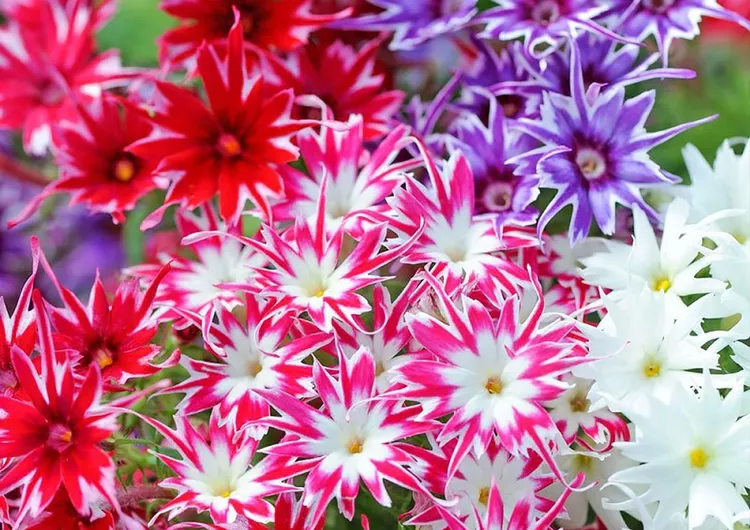Annuals are the way to add quick, long-lasting color to your garden. While familiar varieties such as petunias and zinnias are reliable options, including something a little different is always fun. One uncommon annual that's sure to stop you in your tracks is 'Popstars' phlox. Popular in Europe, this variety of annual phlox (Phlox drummondii) has been catching on in the United States in recent years, and for good reason. These low-growing plants, also called star phlox because of the shape of their flowers, bloom in bright colors all summer long and are super easy to grow. The 'Popstars' series comes in a mix of colors, including white, pink, red, purple, and bicolors, creating a spectacular floral fireworks display wherever they're planted.
Where to Plant 'Popstars' Phlox
Plant 'Popstars' phlox in a sunny spot because these beauties bloom best in full sun, although they'll do just fine in part shade, too. This annual phlox prefers well-drained soil and plenty of moisture.
Growing about 10 inches tall and wide, 'Popstars' phlox works best toward the front of garden beds or around the edges of a container. For maximum impact, try these plants along an entryway for a cheerful welcome or as filler in your patio pots. You can group several phlox plants together to create a heap of colors and textures or pair them with other annuals and perennials. You can leave the flowers in your landscape or cut them for a bouquet.
How and When to Plant 'Popstars' Phlox
If you've never grown annual phlox before, no problem. They're easy to start from seed, either indoors 6-8 weeks before your frost-free date or outdoors in the garden once the weather stays consistently warm.
When starting indoors, place each seed in the center of a 4-inch pot filled with well-draining seed-starting mix. Cover it with 1/8 inch of planting medium; the seeds require dark to germinate. Place the pots in a warm area and keep the planting medium moist until the seeds germinate.
Direct sow the seeds outside in a prepared garden bed after the last spring frost date and cover them with 1/8 inch of soil. The best temperature for sowing outside is 60°F-65°F.
You can purchase 'Popstars' phlox seeds from several online retailers. The red and white bicolor version of Popstars phlox is available on Amazon for $9. Add these annual phlox plants to your garden, and you'll be able to enjoy a vibrant flower display all summer long.
'Popstars' Phlox Care Tips
Light
You can't go wrong planting these summer stars in full sun; they thrive there. They'll also grow in partial shade, but the amount of blooms may be reduced.
Soil and Water
Well-draining soil is essential for the best results with annual phlox. If the soil is not well-draining, amend it with compost before planting seeds or transplants. Water phlox when the top inch of soil is dry.
Temperature and Humidity
'Popstars' phlox prefers warm—not hot—temperatures, preferably in the 60°F- 75°F range. As annuals, they die when the weather grows cold. They may live at 30°F, but all blooming will stop. Although they enjoy moist soil, they are not fans of high humidity.
Fertilizer
Fertilize with an all-purpose plant fertilizer that is low in nitrogen once a month, beginning as buds form. Follow the instructions on the product packaging to keep your plants going strong until frost.
Pruning
'Popstars' phlox is self-cleaning, meaning you don't need to deadhead the faded blooms. If the flowers seem to be slowing down, give your plants a light shearing to encourage more buds to develop.
Potting and Repotting
All annual phlox plants make excellent container plants, and 'Popstars' phlox is no exception. Fill a wide container that has good drainage with potting soil, keeping in mind that your transplants may reach a width of 10 inches before the summer is over. Find a place that receives full sun for the best blooms and keep the potting soil moist. Place the container near a patio or other sitting area so everyone can appreciate its spectacular star-shaped blooms all summer. In winter, the annual will die, so repotting isn't necessary.
Pests and Problems
Spider mites can be a problem for annual phlox. If you spot this pest, treat the plants with neem oil.
'Popstar' phlox plants growing in areas with high humidity are likely to have problems with powdery mildew. Water these plants at the base and avoid splashing water on the foliage. Also, planting them a little farther apart than usual encourages good airflow.
How to Propagate 'Popstars' Phlox
Annual phlox often reseeds itself if you leave the flowers on the plants, so it may come back for you the following year without needing to be replanted.
However, "Popstars" phlox is a patented plant, so it can only be propagated legally from purchased seed. If you love this plant, purchase a package of seeds each year.
When Propagating Your Plant Is Illegal
Types of 'Popstars' Phlox
'Popstars' is a patented type of annual phlox. When shopping for seeds, you'll find solid colors of white, purple, deep blue, and red, along with rose with white eye and purple with a white eye. Many seed providers also offer a mix of several colors. Try them all for a summer filled with color.




















